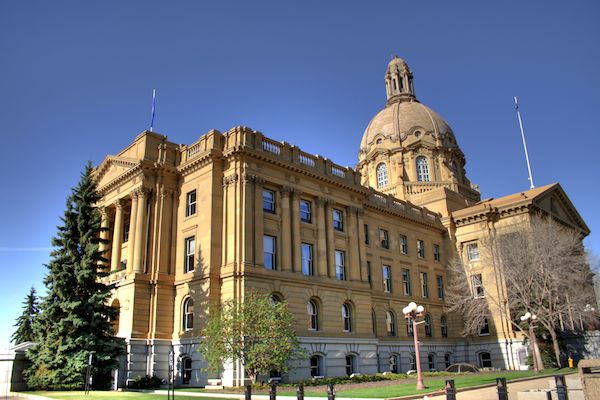Alberta
Alberta Q1 budget update a VERY nice surprise

Q1 update: Alberta’s Recovery Plan is working
The government’s economic outlook has dramatically improved over the first three months of the fiscal year, confirming that Alberta’s Recovery Plan to diversify the economy and create jobs is working.
As of July, Alberta added 73,000 jobs since the beginning of the year and has now recovered nearly 90 per cent of the jobs lost when the pandemic first took hold in the province.
Real gross domestic product (GDP) is expected to grow by 6.7 per cent in 2021, up significantly from the budget forecast of 4.8 per cent. Many economic forecasters, including the Conference Board of Canada and some of the largest Canadian banks, predict Alberta will lead all provinces in growth this year.
“After a historically challenging year, Alberta’s economy is already witnessing signs of recovery and growth. While this indicates Alberta’s Recovery Plan is working, we know there is still more to do to create jobs and restore Alberta’s place as the economic driver of the nation. We will continue to bring spending in line with that of other provinces, attract more investment and get Albertans back to work.”
Increased investment and economic activity has led to the unemployment rate falling to 8.5 per cent, the lowest since the pandemic started.
Oilsands production has risen more than eight per cent in the first half of the year with a quick rebound in bitumen output and drilling activity in June and July – exceeding 2019 levels. Non-energy investment is forecast to grow at about five per cent each year in 2021 and 2022, and will return to 2019 levels this year.
Fiscal situation
Despite these improvements in Alberta’s economy, a sizeable deficit remains, and Alberta’s current fiscal situation is still unsustainable. Alberta will pay $2.6 billion in debt servicing costs this year, which is more than it spends on all but four government departments. With no debt, these taxpayer dollars could be spent on education, health care and other public services.
While the recent increase in energy prices is encouraging, Alberta’s government is aware the situation can change rapidly and the year is far from over. There have been dramatic fluctuations over the past year and a half. Instead of relying on volatile resource revenue, government must control spending.
Alberta’s government continues to hold three fiscal anchors to guide decision-making:
- Keeping net debt below 30 per cent of GDP.
- Aligning per capita spending with comparator provinces.
- Setting a time frame for balancing the budget once the government has a clear picture of the long-term global impacts of the pandemic.
Quick facts
- The deficit for 2021-22 is forecast at $7.8 billion, $10.5 billion lower than reported in the budget.
- The revenue forecast for 2021-22 is $55 billion, $11.3 billion higher than reported in the budget.
- Expense is forecast at $62.7 billion, up $0.8 billion from the budget.
- Taxpayer-supported debt is forecast at $105.7 billion on March 31, 2022, which is $4.9 billion lower than estimated in the budget.
- The net debt-to-GDP ratio will be an estimated 19.6 per cent at the end of the fiscal year, well below the province’s goal of 30 per cent.
Alberta
Cross-Canada NGL corridor will stretch from B.C. to Ontario

Keyera Corp.’s natural gas liquids facilities in Fort Saskatchewan. Photo courtesy Keyera Corp.
From the Canadian Energy Centre
By Will Gibson
Keyera ‘Canadianizes’ natural gas liquids with $5.15 billion acquisition
Sarnia, Ont., which sits on the southern tip of Lake Huron and peers across the St. Clair River to Michigan, is a crucial energy hub for much of the eastern half of Canada and parts of the United States.
With more than 60 industrial facilities including refineries and chemical plants that produce everything from petroleum, resins, synthetic rubber, plastics, lubricants, paint, cosmetics and food additives in the southwestern Ontario city, Mayor Mike Bradley admits the ongoing dialogue about tariffs with Canada’s southern neighbour hits close to home.
So Bradley welcomed the announcement that Calgary-based Keyera Corp. will acquire the majority of Plains American Pipelines LLP’s Canadian natural gas liquids (NGL) business, creating a cross-Canada NGL corridor that includes a storage hub in Sarnia.
“As a border city, we’ve been on the frontline of the tariff wars, so we support anything that helps enhance Canadian sovereignty and jobs,” says the long-time mayor, who was first elected in 1988.
The assets in Sarnia are a key piece of the $5.15 billion transaction, which will connect natural gas liquids from the growing Montney and Duvernay plays in B.C. and Alberta to markets in central Canada and the eastern U.S. seaboard.
NGLs are hydrocarbons found within natural gas streams including ethane, propane and pentanes. They are important energy sources and used to produce a wide range of everyday items, from plastics and clothing to fuels.
Keyera CEO Dean Setoguchi cast the proposed acquisition as an act of repatriation.
“This transaction brings key NGL infrastructure under Canadian ownership, enhancing domestic energy capabilities and reinforcing Canada’s economic resilience by keeping value and decision-making closer to home,” Setoguchi told analysts in a June 17 call.
“Plains’ portfolio forms a fully integrated cross Canada NGL system connecting Western Canada supply to key demand centres across the Prairie provinces, Ontario and eastern U.S.,” he said.
“The system includes strategic hubs like Empress, Fort Saskatchewan and Sarnia – which provide a reliable source of Canadian NGL supply to extensive fractionation, storage, pipeline and logistics infrastructure.”
Martin King, RBN Energy’s managing director of North America Energy Market Analysis, sees Keyera’s ability to “Canadianize” its NGL infrastructure as improving the company’s growth prospects.
“It allows them to tap into the Duvernay and Montney, which are the fastest growing NGL plays in North America and gives them some key assets throughout the country,” said the Calgary-based analyst.
“The crown assets are probably the straddle plants in Empress, which help strip out the butane, ethane and other liquids for condensate. It also positions them well to serve the eastern half of the country.”
And that’s something welcomed in Sarnia.
“Having a Canadian source for natural gas would be our preference so we see Keyera’s acquisition as strengthening our region as an energy hub,” Bradley said.
“We are optimistic this will be good for our region in the long run.”
The acquisition is expected to close in the first quarter of 2026, pending regulatory approvals.
Meanwhile, the governments of Ontario and Alberta are joining forces to strengthen the economies of both regions, and the country, by advancing major infrastructure projects including pipelines, ports and rail.
A joint feasibility study is expected this year on how to move major private sector-led investments forward.
Alberta
Alberta school boards required to meet new standards for school library materials with regard to sexual content

Alberta’s government has introduced new standards to ensure school library materials are age-appropriate.
School libraries should be safe and supportive places where students can learn and explore without being exposed to inappropriate sexual content. However, in the absence of a consistent standard for selecting age-appropriate library materials, school boards have taken different approaches, leading to concerns about safeguards in place.
In response to these concerns, and informed by feedback from education partners and the public, Alberta’s government has created standards to provide school boards with clear direction on the selection, availability and access to school library materials, such as books.
“Our actions to ensure that materials in school libraries don’t expose children to sexual content were never about banning books. These new standards are to ensure that school boards have clear guidance to ensure age-appropriate access to school library materials, while reflecting the values and priorities of Albertans.”
The new standards set clear expectations for school library materials with regard to sexual content and require school boards to implement policies to support these standards.
Standards for school library materials
Under the new standards, school libraries are not permitted to include library materials containing explicit sexual content. Non-explicit sexual content may be accessible to students in Grade 10 and above, provided it is age-appropriate.
“Protecting kids from explicit content is common sense. LGBTQ youth, like all children, deserve to see themselves in stories that are age-appropriate, supportive and affirming – not in material that sexualizes or confuses them.”
School boards must also regularly review their school library collections, publish a full list of available materials and ensure that a staff member supervises students’ access to school library materials. School boards will have to remove any materials with explicit sexual content from their school libraries by October 1.
School board policies and procedures
All school boards must have publicly available policies that align with the new standards for selecting and managing library materials by January 1, 2026. School boards can either create new policies or update existing ones to meet these requirements.
These policies must outline how school library materials are selected and reviewed, how staff supervise students’ access throughout the school day, and how a student, parent, school board employee or other member of the school community can request a review or removal of materials in the school library. School boards are also required to clearly communicate these policies to employees, students and parents before January 2026.
“A robust, grade- and age-appropriate library catalogue is vital for student success. We welcome the ministry’s initiative to establish consistent standards and appreciate the ongoing consultation to help craft a plan that will serve our families and communities well.”
“Red Deer Public Schools welcomes the new provincial standards for school library materials. Our division is committed to maintaining welcoming, respectful learning spaces where students can grow and thrive. Under the new standards for school libraries, we remain dedicated to providing learning resources that reflect our values and support student success.”
Quick facts
- The new standards will apply to public, separate, francophone, charter and independent schools.
- The ministerial order does not apply to municipal libraries located within schools or materials selected for use by teachers as learning and teaching resources.
- From May 26 to June 6, almost 80,000 people completed an online survey to provide feedback on the creation of consistent standards to ensure the age-appropriateness of materials available to students in school libraries.
Related information
- Ministerial Order
- School library standards engagement
- Reference Materials: Content warning: this document contains graphic content that may be disturbing to viewers and is not appropriate for young viewers. Viewer discretion is advised.
-

 COVID-194 hours ago
COVID-194 hours agoFDA requires new warning on mRNA COVID shots due to heart damage in young men
-

 Business2 hours ago
Business2 hours agoCarney’s new agenda faces old Canadian problems
-

 Indigenous3 hours ago
Indigenous3 hours agoInternal emails show Canadian gov’t doubted ‘mass graves’ narrative but went along with it
-

 Bruce Dowbiggin5 hours ago
Bruce Dowbiggin5 hours agoEau Canada! Join Us In An Inclusive New National Anthem
-

 Business2 days ago
Business2 days agoCannabis Legalization Is Starting to Look Like a Really Dumb Idea
-

 Bruce Dowbiggin2 days ago
Bruce Dowbiggin2 days agoThe Covid 19 Disaster: When Do We Get The Apologies?
-

 Media2 days ago
Media2 days agoCBC journalist quits, accuses outlet of anti-Conservative bias and censorship
-

 Business2 days ago
Business2 days agoCarney government should recognize that private sector drives Canada’s economy




